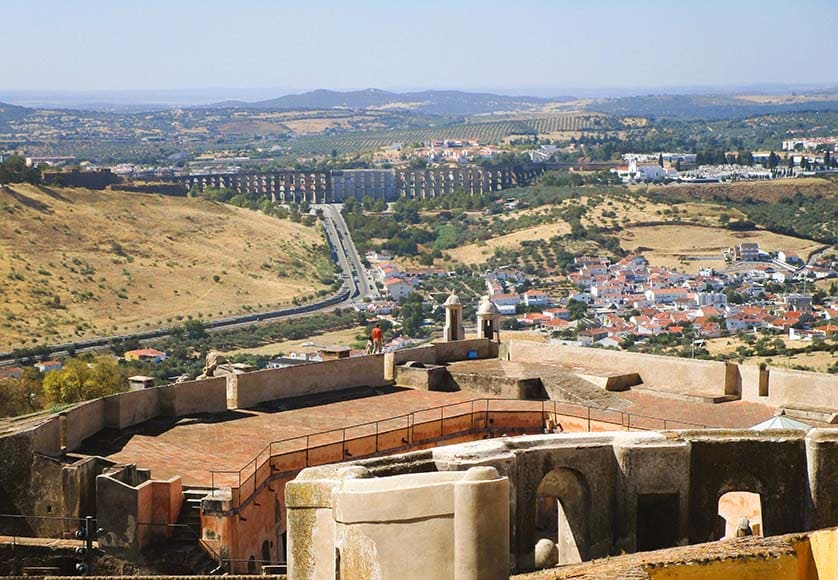Sightseeing in and around the historic and wonderfully preserved town of Elvas is an absolute joy. Elvas itself is one of Portugal’s hidden gems, located in the far east of the country and close to the Spanish border.
It is surrounded by the unspoiled rolling countryside of the Alto (Upper) Alentejo – a kaleidoscopic mix of wheatfields, vineyards, ancient olive groves, cork oak and pastures replete with contentedly grazing cows and sheep. This is a place where sightseeing is best done at a leisurely pace, particularly in summer, when the Alentejo bakes under intense sun and heat.
The rugged landscape of the Portuguese-Spanish border historically made the region surrounding Elvas the natural crossing point between the two countries. As a result, massive defensive construction projects were initiated to make Elvas the first line of defence against possible Spanish invasion. The walls of the city were designed in a clever star shape, so that no side was left unprotected, and a large aqueduct was built to supply clean water in event of siege.
Later, the two hills overlooking Elvas were transformed into mighty forts to provide additional defence. The town successfully fended off three Spanish sieges and only ‘fell’ in 1808 during the Napoleonic wars.
On previous visits, we had explored some of Elvas’s chief attractions – cobbled streets, churches, defensive walls and the ancient castle (originally a Roman fortress). This time, we decided to investigate some of its military history and began in the town’s excellent Military Museum.
It was created from the old Portuguese army barracks, and contains an Elvas Heritage Interpretation Centre, old military vehicles, the history of the army health service, battleground communications and fascinating exhibits associated with horses used in war. We particularly enjoyed viewing the field ambulance and portable dentist equipment!
The two lovingly restored forts on the hills overlooking Elvas are well worth exploration. The Fort of Graça is the larger and dates back to the 1760s. Like the town itself, its walls are star-shaped, and the massive structure sits on earthworks above the hill’s steep slopes, making it an imposing problem for attacking forces.
Internally, the construction included a complex labyrinth of internal passages that reached every conceivable corner – perhaps the perfect venue for a world ‘hide and seek’ championship!
The fort has a superb view of Elvas and its aqueduct and is topped by the elegant Governor’s House. Clearly, this gentleman lived in some style. The Santa Luzia Fort is smaller but no less interesting, and dates from the 1640s. Its clever zigzag-walled design is yet another example of superb military architecture. However, the first lines of defence, outside the walls, were ditches supported by cunningly disguised mantraps.
The fort actually had an escape tunnel right into Elvas itself, so in event of the defences being breached by the enemy, the soldiers could readily escape. The first stretch of this mysterious tunnel remains open to visitors.
The fort had its own chapel and a sophisticated rainwater collection system. An Army Museum on site has a collection of weapons and uniforms from the Middle Ages onwards, plus displays of the various border conflicts. There is an extensive view of the whole Spanish border region from the parapets of the fort’s Governor’s House.
Exploring the local area, we drove north from Elvas through a pastoral landscape, visiting the rural villages of São Vicente and Santa Eulália – notable for their squat little houses and bulky chimneys.
Our destination was the ancient town of Alter do Chão, but there were places of interest on route, notably the lovely village of Cabeço de Vide.
The town’s old railway station is an absolute gem with beautiful azulejos portraying rural life. The road approaching the station has a magnificent avenue of Plane Trees. Sadly, the railway line closed many years ago, but nearby there are thermal baths used for therapeutic treatments, that were originally used by the Romans.
Alter do Chão was an unexpected delight! It is a well-groomed and attractive town with a quite splendid old 14th century castle at its centre. In the nearby gardens there are some colourful aluzejos depicting rural dancing.
The town, which dates back to Roman times, is most famous for the breeding of the Lusitanian horse, the Alter Real. The Royal Stud was set up here in 1748 and these horses are still much admired by equestrian enthusiasts.
We made our return journey via the picturesque Barragem do Caia, impressively situated in the scenic Alentejo landscape. This lake is the main water supply for Elvas and presented a scene of total serenity. We were the only visitors and had for company just some quietly quacking ducks and a pair of buzzards ‘mewing’ in the deep blue sky far above.
West of Elvas, not far from the town of Redondo, lies a modest range of hills, rising to 650m and called the Serra de Ossa. Rarely visited by foreign tourists, it is a tranquil forested region and one of Portugal’s main cork-producing areas.
Aldeia da Serra is a long and pretty village at the foot of the hills, and on the wooded slopes high above sits the Convento São Paulo. This beautiful convent has been transformed into a four-star hotel which retains the peace and calm you would expect of a once religious retreat. It has a stunning interior, boasting over 50,000 azulejos, a superb refectory and a charming cloister.
We enjoyed a light lunch overlooking the cloister and couldn’t help thinking that this hotel would be the perfect setting for an Agatha Christie murder mystery – one itching to be solved by Hercule Poirot. We could easily imagine the little Belgian detective savouring his soup course with his serviette tucked very precisely into his collar! He would, of course, be quietly discussing the potential murder suspects with his trusted ‘mon ami’, Captain Hastings!
For most people, a visit to Evoramonte is the highlight of any exploration of the Serra de Ossa. This medieval village is perched precariously on top of a hill at the extreme western end of the range. Its 14th century castle is said to have had Roman origins and dominates one end of the main street. The pretty church with its colourful graveyard sits at the other extremity.
After enjoying the ambience and great views from this lofty hilltop, we tried the tasty ‘prato do dia’ served at the popular little café in the settlement far below. Their delicious lunch was yet another of this region’s wonderful surprises!
Whenever we visit this part of the Alentejo, we always stay at the Hotel Rural Monte da Provença, a few kilometres north of Elvas. It is a former convent and has been tastefully converted into a remarkably comfortable small hotel with all modern amenities. It is full of charm, has an excellent cuisine, welcoming staff, gorgeous pool area, immaculately kept gardens and is surrounded by nature and wildlife. It is a perfect place for an Alentejo weekend away.
By Nigel Wright
|| features@algarveresident.com
Nigel Wright and his wife Sue moved to Portugal 15 years ago and live near Guia. They lived and worked in the Far East and Middle East during the 1980s and 90s, and although now retired, still continue to travel and seek out new cultural experiences. His other interests include tennis, gardening and photography.




















